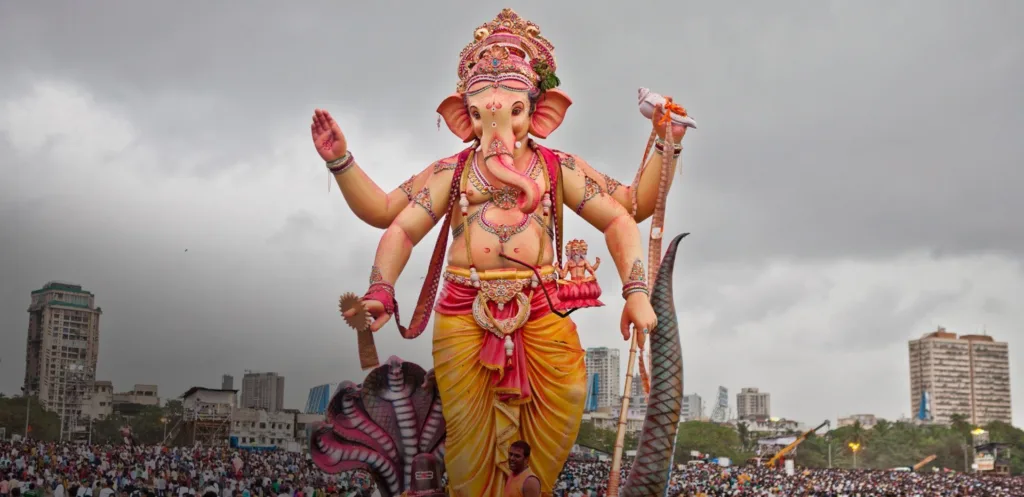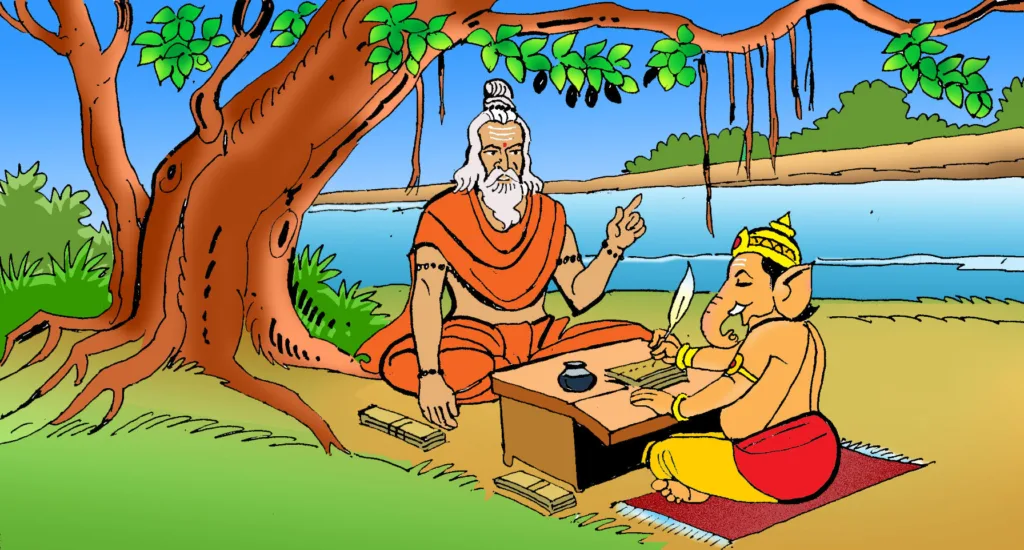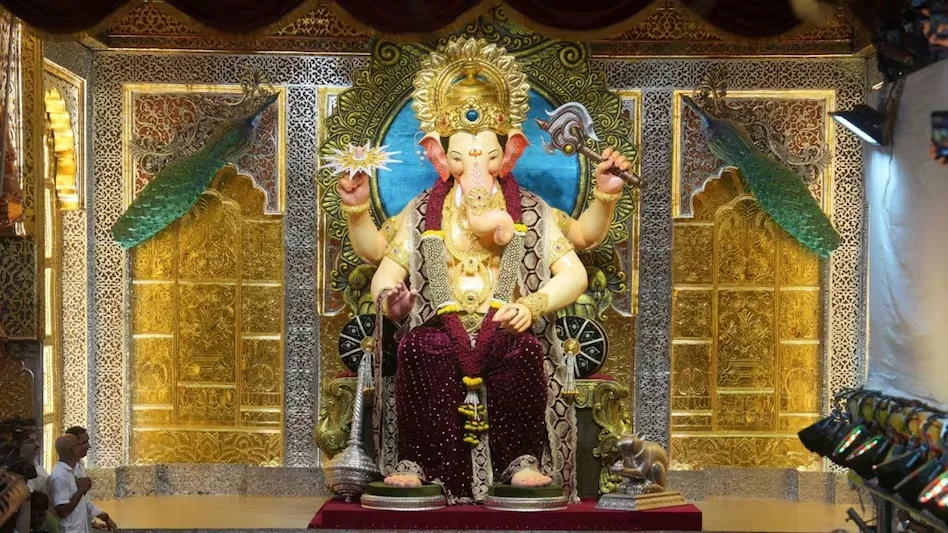Explore the fascinating Ganesh Chaturthi Story in English, from Lord Ganesha’s birth to Vinayak Chaturthi rituals and modern eco-friendly celebrations.

Outline – Ganesh Chaturthi Story in English
| Main Headings | Subheadings |
| Introduction | -The significance of Ganesh Chaturthi in Hindu culture. -Why it is celebrated worldwide, especially in the U.S. -Brief mention of the key themes: faith, wisdom, and prosperity. |
| The Birth Story of Lord Ganesha | -The creation of Ganesha by Goddess Parvati. -Ganesha’s guarding of Parvati’s bath. -The confrontation with Lord Shiva. -The tragic beheading and the ultimate restoration with an elephant’s head. |
| Why Do We Celebrate Ganesh Chaturthi? | -Religious significance of Lord Ganesha’s birth. -The festival’s message of overcoming obstacles and gaining wisdom. -The mythological importance of the elephant head in Hindu culture. |
| How Is Ganesh Chaturthi Celebrated? | -Detailed description of the festival rituals: installation of idols, prayers, and offerings. -The 10-day celebrations culminating in the immersion of Ganesha idols. -Regional variations of the festival across India and the world. |
| Ganesh Chaturthi Celebrations in the United States | -How Hindu communities in the U.S. celebrate the festival. -The rise of eco-friendly celebrations. -Cultural significance for Indian-Americans. |
| Vinayak Chaturthi Story in English for Kids | -A simplified retelling of the birth of Lord Ganesha. -Lessons of obedience, patience, and wisdom that children can take away from the story. |
| Symbolism of Lord Ganesha | -The symbolism behind Ganesha’s elephant head, large ears, and potbelly. -How Ganesha’s traits relate to overcoming challenges in modern life. |
| Ganesh Visarjan: The End of the Festival | -The significance of immersing the Ganesha idols in water. -How this symbolizes the cycle of life, death, and rebirth. |
| Eco-Friendly Celebrations | -The rise of eco-friendly Ganesh idols. -How environmental awareness has become an important aspect of modern celebrations, especially in the U.S. |
| FAQs – Story of Ganesh Chaturthi in English | Common questions about Ganesh Chaturthi, such as: -What is Ganesh Chaturthi? -Why do we celebrate Ganesh Visarjan? -How can I celebrate Ganesh Chaturthi in the U.S.? -What is the meaning behind the elephant head of Ganesha? -How long does the festival last? |
| Conclusion : Story of Ganesh Chaturthi in English | -The lasting impact of Ganesh Chaturthi on communities worldwide. -A reflection on the personal lessons we can take from Lord Ganesha’s story. |
1. Introduction
Ganesh Chaturthi, or Vinayak Chaturthi, is a significant Hindu festival in the United States that celebrates the birth of Lord Ganesha, the elephant-headed deity symbolizing the removal of obstacles and the embodiment of wisdom, prosperity, and new beginnings. Lasting typically 10 days, the festival expresses love and devotion to Ganesha and conveys timeless lessons about patience, devotion, and the triumph of good over evil, reflecting the human experience of overcoming challenges and highlighting its deep cultural significance. The Ganesh Chaturthi story in English is not just about a myth but also a reflection of the human experience of overcoming life’s challenges.
2. The Birth Story of Lord Ganesha

Ganesh Chaturthi Story in English-The birth of Lord Ganesha is one of the most beautiful and poignant stories in Hindu mythology. It is a story that resonates with love, devotion, and the undying bond between a mother and her child.
Long ago, when the gods roamed the earth, Goddess Parvati, wife of Lord Shiva, was preparing for her daily bath. To ensure her privacy, she decided to create a guardian for herself. Using sandalwood paste and divine power, she shaped a boy from the paste and breathed life into him. This boy, with his radiant beauty and youthful vigor, was named Ganesha.
One day, while Parvati was bathing, she asked Ganesha to stand guard at the door and allow no one to enter. As fate would have it, Lord Shiva returned home that day. Ganesha, having never met his father, refused to let him in, following his mother’s strict instructions. A fierce argument ensued, and in his anger, Shiva, unaware that Ganesha was his own son, severed Ganesha’s head with his trident.
Upon hearing the tragic news, Parvati was inconsolable. Her heartbroken cries shook the heavens, and in her grief, she threatened to destroy the universe. The gods pleaded with Shiva to rectify the situation. Realizing his mistake, Lord Shiva sent his celestial followers to find the head of the first living being they encountered. They returned with the head of a mighty elephant, which Shiva placed on Ganesha’s body, restoring him to life. From that day, Ganesha became known as the elephant-headed god, revered as the remover of obstacles and the harbinger of good fortune.
3. Why Do We Celebrate Ganesh Chaturthi?
Ganesh Chaturthi is celebrated as the day Lord Ganesha was born, symbolizing the birth of wisdom, prosperity, and new beginnings. The Ganesh Chaturthi Story in English carries a profound message: even the greatest obstacles can be overcome with patience, devotion, and the blessings of the divine. The festival teaches us to face challenges head-on, just as Ganesha did when confronted with his father. His elephant head, a symbol of strength and wisdom, reminds us that life’s challenges can be transformed into opportunities for growth.
This festival is also a time to seek Ganesha’s blessings for success, whether in education, work, or personal endeavors. Hindus believe that worshipping Ganesha at the start of any new venture removes any obstacles and ensures success.
4. How Is Ganesh Chaturthi Celebrated?
The celebration of Ganesh Chaturthi is a vibrant and joyful affair. It begins with the installation of clay idols of Lord Ganesha in homes and public pandals (temporary stages). The idols, ranging from small to enormous, are beautifully adorned with flowers, lights, and offerings. Families gather to perform daily rituals known as aarti and offer sweets like modaks, which are said to be Ganesha’s favorite.
The ten days of Ganesh Chaturthi are filled with prayers, singing, and dancing, as communities come together to honor the god who brings them prosperity. On the final day, the idol is carried in a grand procession, accompanied by music and chants of “Ganapati Bappa Morya!” This procession leads to a nearby body of water, where the idol is immersed in a ritual known as Ganesh Visarjan. This symbolizes the cycle of creation and dissolution, reminding us of the impermanence of life.
5. Ganesh Chaturthi Celebrations in the United States
Ganesh Chaturthi Story in English-In recent years, the celebration of Ganesh Chaturthi has gained widespread popularity among the Indian diaspora in the United States. Indian-Americans, yearning for a connection to their roots, have adopted and adapted this festival with great enthusiasm, ensuring that the cultural essence remains intact, even on foreign soil.
In cities like New York, San Francisco, and Chicago, large-scale public celebrations take place, often organized by local Hindu temples and cultural organizations. The grandeur of the festival mirrors the festivities in India, with beautifully crafted Ganesha idols, prayers, and cultural performances. What makes the U.S. celebrations unique is the fusion of Indian traditions with American environmental consciousness. Many organizers in the U.S. have taken steps to promote eco-friendly celebrations, using biodegradable materials for the idols to prevent pollution during the Ganesh Visarjan.
Families in the U.S. also perform rituals in their homes, decorating their idols and offering prayers as they would in India. However, for the second and third-generation Indian-Americans, Ganesh Chaturthi has taken on a dual significance. It not only symbolizes devotion to Lord Ganesha but also serves as a reminder of their rich cultural heritage, providing a sense of belonging and identity in their adopted homeland.
6. Vinayak Chaturthi Story in English for Kids
For children, the Vinayak Chaturthi Story in English holds a special place, as it conveys important life lessons through an engaging tale. In simple words, it teaches kids about loyalty, love, and the consequences of one’s actions.
In the retelling of Lord Ganesha’s birth, children are introduced to the bond between Parvati and Ganesha. They learn that Ganesha, like any child, was obedient to his mother and stood firm in protecting her privacy. Despite the tragic misunderstanding between him and Lord Shiva, Ganesha’s transformation with the elephant’s head reminds kids that mistakes happen, but they can be overcome with love and wisdom.
This version of the story highlights that even though Ganesha faced a great challenge, he was restored to life and became a god known for his wisdom and kindness. Parents often explain to their children that Ganesha’s large ears teach them to listen well, his small eyes remind them to focus, and his large belly symbolizes the need to accept all experiences—good and bad—with grace.
By teaching these values, the Vinayak Chaturthi Story in English becomes not just a myth, but a moral compass that helps children navigate the complexities of life.
7. Symbolism of Lord Ganesha
The elephant-headed god, Lord Ganesha, is rich with symbolism, each of his features embodying wisdom, strength, and spiritual insight.
- The Elephant Head: The most recognizable aspect of Ganesha is his elephant head, which represents wisdom, understanding, and a unique way of thinking. Elephants are known for their intelligence and their ability to remove obstacles from their path, much like Ganesha clears the way for his devotees.
- Large Ears and Small Eyes: Ganesha’s large ears signify the importance of listening carefully and attentively, while his small eyes indicate focus. Together, these features encourage us to listen more and speak less, ensuring that we truly understand before making decisions.
- His Potbelly: Ganesha’s large belly symbolizes the capacity to digest both the good and bad experiences of life, reminding us to embrace life’s dualities and learn from every situation.
- The Trunk: Ganesha’s trunk is a tool of great flexibility, representing adaptability and the ability to overcome all obstacles with both strength and grace.
Ganesha is a symbol of everything we aspire to be: wise, compassionate, and strong in the face of adversity. His presence in homes and temples is a reminder that we can overcome any obstacle with patience and perseverance.
8. Ganesh Visarjan: The End of the Festival
The culmination of Ganesh Chaturthi is the Ganesh Visarjan, where the idols of Lord Ganesha are immersed in water, symbolizing the return of the deity to his heavenly abode. This act of immersion is deeply spiritual, signifying the ephemeral nature of life and the importance of detachment.
For devotees, the visarjan is an emotional moment. After days of prayers, devotion, and festivity, they bid farewell to their beloved Ganpati Bappa, knowing that he will return again next year. The immersion ritual teaches that while the physical form may disappear, Ganesha’s blessings and wisdom remain with us forever.
In the United States, many families and communities have embraced the tradition of Ganesh Visarjan in environmentally conscious ways. Instead of immersing idols in lakes or rivers, some use water tanks or perform symbolic immersions using small clay idols that dissolve harmlessly in water.
9. Eco-Friendly Celebrations

In recent years, there has been a significant movement towards celebrating Ganesh Chaturthi in an eco-friendly manner. With growing awareness of environmental issues, many communities in the U.S. and India have begun using idols made from natural clay and organic paints, which dissolve easily in water without harming aquatic life.
This shift has brought a deeper layer of consciousness to the festival. It reminds devotees that while we celebrate Ganesha, the remover of obstacles, we must also respect and protect the environment. By making the festival sustainable, we ensure that future generations can continue to celebrate this beautiful tradition without causing harm to the planet.
In the U.S., this eco-friendly trend has been widely embraced by temples and cultural organizations, which promote the use of biodegradable materials and encourage people to adopt environmentally responsible practices.
10. FAQs about Ganesh Chaturthi
What is Ganesh Chaturthi?
Ganesh Chaturthi is a Hindu festival that celebrates the birth of Lord Ganesha, the elephant-headed god of wisdom and prosperity.
Why do we celebrate Ganesh Visarjan?
Ganesh Visarjan marks the end of the Ganesh Chaturthi festival. It symbolizes the cycle of creation and dissolution and teaches us to embrace the transient nature of life.
How is Ganesh Chaturthi celebrated in the U.S.?
In the U.S., the festival is celebrated with devotion, featuring public processions, rituals, and eco-friendly idol immersions, particularly in Indian-American communities.
What is the significance of Ganesha’s elephant head?
Ganesha’s elephant head symbolizes wisdom, strength, and the ability to overcome obstacles, qualities that are revered in Hindu culture.
What are some eco-friendly ways to celebrate Ganesh Chaturthi?
Many devotees now use natural clay idols, avoid synthetic decorations, and immerse idols in water tanks to protect the environment.
11. Conclusion – Ganesh Chaturthi story in English
The Ganesh Chaturthi story in English is a tale that resonates deeply with both adults and children alike. It is a story of love, faith, and transformation, teaching us that through devotion and perseverance, even the greatest obstacles can be overcome. As the festival is celebrated around the world, especially in the United States, it brings communities together in a spirit of joy, unity, and reverence for the divine.
The birth of Lord Ganesha, his lessons of wisdom, and the beautiful rituals of the festival remind us of the cyclical nature of life. As we bid farewell to Ganesha during the Visarjan, we carry his blessings and teachings in our hearts, knowing that he will return next year to guide and protect us once again.
Ganapati Bappa Morya!

